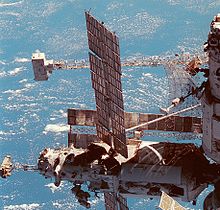WDU
WDU (ros. Выносная Двигательная Установка, zewnętrzny system silnikowy) – samodzielny zewnętrzny system silników, używany do kontroli położenia stacji Mir. Dzięki umieszczeniu na maszcie Sofora (na kadłubie modułu Kwant-1) i odsunięciu od osi stacji, pozwalał na oszczędności paliwa na poziomie 85% i wyższą wydajność niż silniki systemu RCS na kadłubie[1].
WDU miał kształt prostopadłościanu o długości 2,2 m. Samodzielne urządzenie zawierało silniki typu 11D428A-10 napędzane mieszanką tetratlenku diazotu z UDMH oraz jednorazowe zbiorniki z paliwem.
Stacja wyposażona była w dwa kolejne systemy WDU. Pierwszy z nich, WDU-1, został wyniesiony w sierpniu 1992 roku na pokładzie statku Progress-M 14[2][1]. Kiedy wyczerpało się w nim paliwo, został zastąpiony przez WDU-2, wyniesiony w marcu 1998 na pokładzie statku Progress-M 38[1].
Przypisy
Media użyte na tej stronie
Russia's Mir space station is backdropped over the blue and white planet Earth in this medium range photograph recorded during the final fly-around of the members of the fleet of NASA's shuttles. Seven crew members, including Andrew S.W. Thomas, were aboard the Space Shuttle Discovery when the photo was taken; and two of his former cosmonaut crewmates remained aboard Mir. Thomas ended up spending 141 days in space on this journey, including time aboard Space Shuttles Endeavour and Discovery, which transported him to and from Mir.
A view of the Soviet/Russian space station Mir showing some of the station's main unpressurised components. The large scaffolding-like structure visible behind Kvant-2 is the Sofora girder, with the VDU thruster block mounted to its far end. One of the station's Strela cargo cranes (the white, tubular structure stretching from Priroda to Kvant-2) is also visible. The cosmonaut manoeuvring unit, or SPK, can be seen at the lower left, attached to a mounting bracket on the end of Kvant-2, and the ASPG-M scan platform is visible at the bottom of the image, also mounted to Kvant-2. Finally, a large synthetic aperture radar dish, called TRAVERS, can be seen projecting from Priroda.



